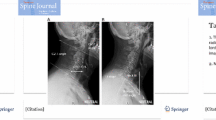Abstract
Purpose
Cervical sagittal balance is a complex phenomenon, influenced by many factors, which cannot be described by cervical lordosis alone. Attention has been focused on the relationship between T1 slope, thoracic inlet angle, and cervical sagittal balance. However, the effect of cervical position on these parameters has not been evaluated yet. The aim of this study was to assess the influence of cervical flexion and extension on radiographic thoracic inlet parameters.
Methods
60 patients with one level radiculopathy symptoms underwent radiological examination. Mean age was 53 (40–72) years; there were 24 males and 34 females. Lateral standing X-rays of cervical spine were taken on the same day in neutral position, full flexion and full extension. Patients with previous cervical operations or congenital malformations were excluded. Thoracic inlet angle (TIA), neck tilt (NT) and thoracic (T1) slope were measured. Agreement between measurements was assessed and quantified by intra-class correlation coefficient (ICC) and median error for a single measurement (SEM). The ICC value greater than 0.75 reflected sufficient agreement.
Results
The mean values of the parameters were: (1) for the neutral position: TIA 71.7° ± 9.5°; T1 slope 26.7° ± 6.3°; and NT 44.9° ± 7.2°, (2) In extension: TIA 71.8° ± 9.4°; T1 slope 24.9° ± 7.6°; and NT 46.9° ± 7.2° and (3) In flexion 78.3° ± 10.3°; T1 slope 33.6° ± 7.8°; and NT 44.7° ± 7.4°. An excellent agreement was revealed for all NT measurements (ICC 0.76) and for TIA measured in flexion and neutral position (ICC 0.79). There was insufficient overall and in-pairs agreement for T1 slope measurements.
Conclusions
Neck tilt measurements were not influenced by position of the cervical spine. T1 slope was significantly influenced by flexion and extension of the neck. This puts the concept that TIA is a morphologic parameter into question. This information should be taken into consideration when analyzing lateral radiographs of the cervical spine for clinical decision-making.


Similar content being viewed by others
References
Scheer JK, Tang JA, Smith JS, Acosta FL Jr, Protopsaltis TS, Blondel B, Bess S, Shaffrey CI, Deviren V, Lafage V, Schwab F, Ames CP, International Spine Study G (2013) Cervical spine alignment, sagittal deformity, and clinical implications: a review. J Neurosurg Spine 19:141–159
Le Huec JC, Saddiki R, Franke J, Rigal J, Aunoble S (2011) Equilibrium of the human body and the gravity line: the basics. Eur Spine J 20(Suppl 5):558–563
Knott PT, Mardjetko SM, Techy F (2010) The use of the T1 sagittal angle in predicting overall sagittal balance of the spine. Spine J 10:994–998
Lee S, Kim K, Seo E, Suk K, Kwack Y, Son E (2012) The influence of thoracic inlet alignment on the craniocervical sagittal balance in asymptomatic adults. J Spinal Disord Tech 25:E41–E47
Lee SH, Son ES, Seo EM, Suk KS, Kim KT (2015) Factors determining cervical spine sagittal balance in asymptomatic adults: correlation with spinopelvic balance and thoracic inlet alignment. Spine J 15(4):705–712
Urschel HC (2007) Anatomy of the thoracic outlet. Thorac Surg Clin 17:511–520
Schwab F, Lafage V, Patel A, Farcy J-P (2009) Sagittal plane considerations and the pelvis in the adult patient. Spine 34:1828–1833
Streiner DL, Norman GR (2008) Health measurement scales : a practical guide to their development and use. Oxford University Press, Oxford
Ohara A, Miyamoto K, Naganawa T, Matsumoto K, Shimizu K (2006) Reliabilities of and correlations among five standard methods of assessing the sagittal alignment of the cervical spine. Spine 31:2585–2591
Harrison DE, Harrison DD, Cailliet R, Troyanovich SJ, Janik TJ, Holland B (2000) Cobb method or Harrison posterior tangent method which to choose for lateral cervical radiographic analysis. Spine 25:2072–2078
Park MS, Moon S-H, Lee H-M, Kim SW, Kim T-H, Lee SY, Riew KD (2013) The effect of age on cervical sagittal alignment: normative data on 100 asymptomatic subjects. Spine 38:E458–E463
Jun HS, Chang IB, Song JH, Kim TH, Park MS, Kim SW, Oh JK (2014) Is it possible to evaluate the parameters of cervical sagittal alignment on cervical computed tomographic scans? Spine 39:E630–E636
Park JH, Cho CB, Song JH, Kim SW, Ha Y, Oh JK (2013) T1 slope and cervical sagittal alignment on cervical CT radiographs of asymptomatic persons. J Korean Neurosurg Soc 53:356–359
Morita D, Yukawa Y, Nakashima H, Ito K, Yoshida G, Machino M, Kanbara S, Iwase T, Kato F (2014) Range of motion of thoracic spine in sagittal plane. Eur Spine J 23:673–678
Fiebert IM, Spyropoulos T, Peterman D, Dotson L (1993) Thoracic segmental flexion during cervical forward bending. J Back Musculoskelet Rehabil. 3:80–85
Bland JM, Altman DG (1986) Statistical methods for assessing agreement between two methods of clinical measurement. Lancet 1:307–310
Weir JP (2005) Quantifying test-retest reliability using the intraclass correlation coefficient and the SEM. J Strength Cond Res. 19:231–240
Kottner J, Audige L, Brorson S, Donner A, Gajewski BJ, Hrobjartsson A, Roberts C, Shoukri M, Streiner DL (2011) Guidelines for reporting reliability and agreement studies (GRRAS) were proposed. J Clin Epidemiol 64:96–106
Conflict of interest
None.
Author information
Authors and Affiliations
Corresponding author
Rights and permissions
About this article
Cite this article
Janusz, P., Tyrakowski, M., Glowka, P. et al. Influence of cervical spine position on the radiographic parameters of the thoracic inlet alignment. Eur Spine J 24, 2880–2884 (2015). https://doi.org/10.1007/s00586-015-4023-x
Received:
Revised:
Accepted:
Published:
Issue Date:
DOI: https://doi.org/10.1007/s00586-015-4023-x




